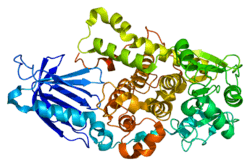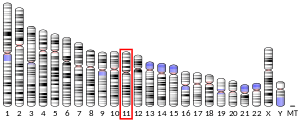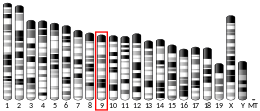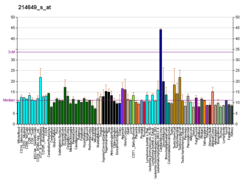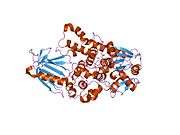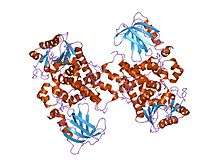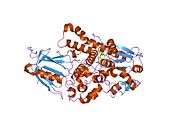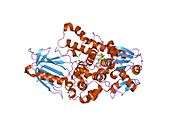MTMR2
Myotubularin-related protein 2 also known as phosphatidylinositol-3,5-bisphosphate 3-phosphatase or phosphatidylinositol-3-phosphate phosphatase is a protein that in humans is encoded by the MTMR2 gene.[5][6][7][8]
Function
This gene is a member of the myotubularin family and encodes a putative tyrosine phosphatase. The protein also contains a GRAM domain.[5] Mutations in this gene are a cause of Charcot-Marie-Tooth disease type 4B, an autosomal recessive demyelinating neuropathy. Multiple alternatively spliced transcript variants have been found, but the biological validity of some variants has not been determined.[8]
Interactions
MTMR2 has been shown to interact with SBF1.[9]
gollark: Green is "OK", with brightness representing latency, black is timeout, orange is HTTP error, red is fetch error of some sort, purple is server failure.
gollark: The full image is 12 weeks of historical data.
gollark: They are status monitoring. Each pixel represents a ping. Pings occur once per 30 seconds.
gollark: I see.
gollark: You don't have push notifications?
References
- GRCh38: Ensembl release 89: ENSG00000087053 - Ensembl, May 2017
- GRCm38: Ensembl release 89: ENSMUSG00000031918 - Ensembl, May 2017
- "Human PubMed Reference:". National Center for Biotechnology Information, U.S. National Library of Medicine.
- "Mouse PubMed Reference:". National Center for Biotechnology Information, U.S. National Library of Medicine.
- "RecName: Full=Myotubularin-related protein 2; AltName: Full=Phosphatidylinositol-3,5-bisphosphate 3-phosphatase; AltName: Full=Phosphatidylinositol-3-phosphate phosphatase". Retrieved March 7, 2020.
- Laporte J, Hu LJ, Kretz C, Mandel JL, Kioschis P, Coy JF, Klauck SM, Poustka A, Dahl N (Jul 1996). "A gene mutated in X-linked myotubular myopathy defines a new putative tyrosine phosphatase family conserved in yeast". Nat. Genet. 13 (2): 175–82. doi:10.1038/ng0696-175. PMID 8640223.
- Laporte J, Blondeau F, Buj-Bello A, Tentler D, Kretz C, Dahl N, Mandel JL (Dec 1998). "Characterization of the myotubularin dual specificity phosphatase gene family from yeast to human". Hum. Mol. Genet. 7 (11): 1703–12. doi:10.1093/hmg/7.11.1703. PMID 9736772.
- "Entrez Gene: MTMR2 myotubularin related protein 2".
- Kim SA, Vacratsis PO, Firestein R, Cleary ML, Dixon JE (Apr 2003). "Regulation of myotubularin-related (MTMR)2 phosphatidylinositol phosphatase by MTMR5, a catalytically inactive phosphatase". Proc. Natl. Acad. Sci. U.S.A. 100 (8): 4492–7. doi:10.1073/pnas.0431052100. PMC 153583. PMID 12668758.
Further reading
- Previtali SC, Quattrini A, Bolino A (2007). "Charcot-Marie-Tooth type 4B demyelinating neuropathy: deciphering the role of MTMR phosphatases". Expert Rev Mol Med. 9 (25): 1–16. doi:10.1017/S1462399407000439. PMID 17880751.
- Begley MJ, Taylor GS, Brock MA, Ghosh P, Woods VL, Dixon JE (2006). "Molecular basis for substrate recognition by MTMR2, a myotubularin family phosphoinositide phosphatase". Proc. Natl. Acad. Sci. U.S.A. 103 (4): 927–32. doi:10.1073/pnas.0510006103. PMC 1347996. PMID 16410353.
- Robinson FL, Dixon JE (2005). "The phosphoinositide-3-phosphatase MTMR2 associates with MTMR13, a membrane-associated pseudophosphatase also mutated in type 4B Charcot-Marie-Tooth disease". J. Biol. Chem. 280 (36): 31699–707. doi:10.1074/jbc.M505159200. PMID 15998640.
- Begley MJ, Taylor GS, Kim SA, Veine DM, Dixon JE, Stuckey JA (2003). "Crystal structure of a phosphoinositide phosphatase, MTMR2: insights into myotubular myopathy and Charcot-Marie-Tooth syndrome". Mol. Cell. 12 (6): 1391–402. doi:10.1016/S1097-2765(03)00486-6. PMID 14690594.
- Previtali SC, Zerega B, Sherman DL, Brophy PJ, Dina G, King RH, Salih MM, Feltri L, Quattrini A, Ravazzolo R, Wrabetz L, Monaco AP, Bolino A (2003). "Myotubularin-related 2 protein phosphatase and neurofilament light chain protein, both mutated in CMT neuropathies, interact in peripheral nerve". Hum. Mol. Genet. 12 (14): 1713–23. doi:10.1093/hmg/ddg179. PMID 12837694.
- Kim SA, Vacratsis PO, Firestein R, Cleary ML, Dixon JE (2003). "Regulation of myotubularin-related (MTMR)2 phosphatidylinositol phosphatase by MTMR5, a catalytically inactive phosphatase". Proc. Natl. Acad. Sci. U.S.A. 100 (8): 4492–7. doi:10.1073/pnas.0431052100. PMC 153583. PMID 12668758.
- Nelis E, Erdem S, Tan E, Löfgren A, Ceuterick C, De Jonghe P, Van Broeckhoven C, Timmerman V, Topaloglu H (2002). "A novel homozygous missense mutation in the myotubularin-related protein 2 gene associated with recessive Charcot-Marie-Tooth disease with irregularly folded myelin sheaths". Neuromuscul. Disord. 12 (9): 869–73. doi:10.1016/S0960-8966(02)00046-9. PMID 12398840.
- Bolino A, Muglia M, Conforti FL, LeGuern E, Salih MA, Georgiou DM, Christodoulou K, Hausmanowa-Petrusewicz I, Mandich P, Schenone A, Gambardella A, Bono F, Quattrone A, Devoto M, Monaco AP (2000). "Charcot-Marie-Tooth type 4B is caused by mutations in the gene encoding myotubularin-related protein-2". Nat. Genet. 25 (1): 17–9. doi:10.1038/75542. PMID 10802647.
- Bolino A, Levy ER, Muglia M, Conforti FL, LeGuern E, Salih MA, Georgiou DM, Christodoulou RK, Hausmanowa-Petrusewicz I, Mandich P, Gambardella A, Quattrone A, Devoto M, Monaco AP (2000). "Genetic refinement and physical mapping of the CMT4B gene on chromosome 11q22". Genomics. 63 (2): 271–8. doi:10.1006/geno.1999.6088. PMID 10673338.
- Kikuno R, Nagase T, Ishikawa K, Hirosawa M, Miyajima N, Tanaka A, Kotani H, Nomura N, Ohara O (1999). "Prediction of the coding sequences of unidentified human genes. XIV. The complete sequences of 100 new cDNA clones from brain which code for large proteins in vitro". DNA Res. 6 (3): 197–205. doi:10.1093/dnares/6.3.197. PMID 10470851.
This article is issued from Wikipedia. The text is licensed under Creative Commons - Attribution - Sharealike. Additional terms may apply for the media files.
